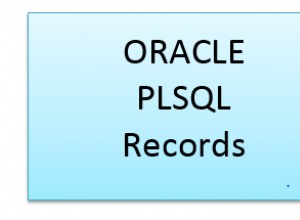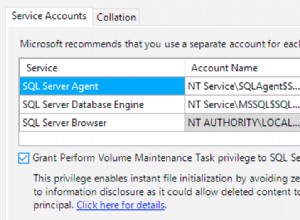Unter der Annahme von Postgres 9.1 oder höher.
Ich habe Ihre grundlegende Abfrage vereinfacht / optimiert, um die neuesten Werte abzurufen:
SELECT DISTINCT ON (1,2)
c.unique_id, a.attname AS col, c.value
FROM pg_attribute a
LEFT JOIN changes c ON c.column_name = a.attname
AND c.table_name = 'instances'
-- AND c.unique_id = 3 -- uncomment to fetch single row
WHERE a.attrelid = 'instances'::regclass -- schema-qualify to be clear?
AND a.attnum > 0 -- no system columns
AND NOT a.attisdropped -- no deleted columns
ORDER BY 1, 2, c.updated_at DESC;
Ich frage den PostgreSQL-Katalog anstelle des Standardinformationsschemas ab, weil das schneller ist. Beachten Sie die spezielle Umwandlung in ::regclass .
Nun, das gibt Ihnen eine Tabelle . Sie möchten alle Werte für eine unique_id in einer Reihe .
Um das zu erreichen, haben Sie grundsätzlich drei Möglichkeiten:
-
Ein Subselect (oder Join) pro Spalte. Teuer und unhandlich. Aber eine gültige Option für nur wenige Spalten.
-
Ein großer
CASEAussage. -
Eine Pivot-Funktion . PostgreSQL stellt die
crosstab()bereit Funktion im Zusatzmodultablefuncdafür.
Grundlegende Anweisungen:- PostgreSQL-Kreuztabellenabfrage
Grundlegende Pivot-Tabelle mit crosstab()
Ich habe die Funktion komplett umgeschrieben:
SELECT *
FROM crosstab(
$x$
SELECT DISTINCT ON (1, 2)
unique_id, column_name, value
FROM changes
WHERE table_name = 'instances'
-- AND unique_id = 3 -- un-comment to fetch single row
ORDER BY 1, 2, updated_at DESC;
$x$,
$y$
SELECT attname
FROM pg_catalog.pg_attribute
WHERE attrelid = 'instances'::regclass -- possibly schema-qualify table name
AND attnum > 0
AND NOT attisdropped
AND attname <> 'unique_id'
ORDER BY attnum
$y$
)
AS tbl (
unique_id integer
-- !!! You have to list all columns in order here !!! --
);
Ich habe die Katalogsuche von der Wertabfrage getrennt, als crosstab() Funktion mit zwei Parametern stellt Spaltennamen separat bereit. Fehlende Werte (kein Eintrag in Änderungen) werden durch NULL ersetzt automatisch. Eine perfekte Ergänzung für diesen Anwendungsfall!
Angenommen, attname stimmt mit column_name überein . Ausgenommen unique_id , die eine besondere Rolle spielt.
Vollständige Automatisierung
Zu Ihrem Kommentar:Es gibt einen Weg um die Spaltendefinitionsliste automatisch zu liefern. Es ist jedoch nichts für schwache Nerven.
Ich verwende hier eine Reihe von erweiterten Postgres-Funktionen:crosstab() , plpgsql-Funktion mit dynamischem SQL, Umgang mit zusammengesetzten Typen, erweiterte Dollarnotierung, Katalogsuche, Aggregatfunktion, Fensterfunktion, Objektkennungstyp, ...
Testumgebung:
CREATE TABLE instances (
unique_id int
, col1 text
, col2 text -- two columns are enough for the demo
);
INSERT INTO instances VALUES
(1, 'foo1', 'bar1')
, (2, 'foo2', 'bar2')
, (3, 'foo3', 'bar3')
, (4, 'foo4', 'bar4');
CREATE TABLE changes (
unique_id int
, table_name text
, column_name text
, value text
, updated_at timestamp
);
INSERT INTO changes VALUES
(1, 'instances', 'col1', 'foo11', '2012-04-12 00:01')
, (1, 'instances', 'col1', 'foo12', '2012-04-12 00:02')
, (1, 'instances', 'col1', 'foo1x', '2012-04-12 00:03')
, (1, 'instances', 'col2', 'bar11', '2012-04-12 00:11')
, (1, 'instances', 'col2', 'bar17', '2012-04-12 00:12')
, (1, 'instances', 'col2', 'bar1x', '2012-04-12 00:13')
, (2, 'instances', 'col1', 'foo2x', '2012-04-12 00:01')
, (2, 'instances', 'col2', 'bar2x', '2012-04-12 00:13')
-- NO change for col1 of row 3 - to test NULLs
, (3, 'instances', 'col2', 'bar3x', '2012-04-12 00:13');
-- NO changes at all for row 4 - to test NULLs
Automatisierte Funktion für eine Tabelle
CREATE OR REPLACE FUNCTION f_curr_instance(int, OUT t public.instances) AS
$func$
BEGIN
EXECUTE $f$
SELECT *
FROM crosstab($x$
SELECT DISTINCT ON (1,2)
unique_id, column_name, value
FROM changes
WHERE table_name = 'instances'
AND unique_id = $f$ || $1 || $f$
ORDER BY 1, 2, updated_at DESC;
$x$
, $y$
SELECT attname
FROM pg_catalog.pg_attribute
WHERE attrelid = 'public.instances'::regclass
AND attnum > 0
AND NOT attisdropped
AND attname <> 'unique_id'
ORDER BY attnum
$y$) AS tbl ($f$
|| (SELECT string_agg(attname || ' ' || atttypid::regtype::text
, ', ' ORDER BY attnum) -- must be in order
FROM pg_catalog.pg_attribute
WHERE attrelid = 'public.instances'::regclass
AND attnum > 0
AND NOT attisdropped)
|| ')'
INTO t;
END
$func$ LANGUAGE plpgsql;
Die Tabelle instances ist fest codiert, schemaqualifiziert, um eindeutig zu sein. Beachten Sie die Verwendung des Tabellentyps als Rückgabetyp. Für jede Tabelle in PostgreSQL wird automatisch ein Zeilentyp registriert. Dies muss dem Rückgabetyp von crosstab() entsprechen Funktion.
Dies bindet die Funktion an den Typ der Tabelle:
- Sie erhalten eine Fehlermeldung, wenn Sie versuchen,
DROPzu machen die Tabelle - Ihre Funktion wird nach einem
ALTER TABLEfehlschlagen . Sie müssen es neu erstellen (ohne Änderungen). Ich halte dies für einen Fehler in 9.1.ALTER TABLEsollte die Funktion nicht stillschweigend unterbrechen, sondern einen Fehler auslösen.
Das funktioniert sehr gut.
Aufruf:
SELECT * FROM f_curr_instance(3);
unique_id | col1 | col2
----------+-------+-----
3 |<NULL> | bar3x
Beachten Sie, wie col1 ist NULL hier.
In einer Abfrage verwenden, um eine Instanz mit ihren neuesten Werten anzuzeigen:
SELECT i.unique_id
, COALESCE(c.col1, i.col1)
, COALESCE(c.col2, i.col2)
FROM instances i
LEFT JOIN f_curr_instance(3) c USING (unique_id)
WHERE i.unique_id = 3;
Volle Automatisierung für jeden Tisch
(Hinzugefügt 2016. Das ist Dynamit.)
Benötigt Postgres 9.1 oder später. (Konnte mit Seite 8.4 funktionieren, aber ich habe mich nicht darum gekümmert, einen Backpatch durchzuführen.)
CREATE OR REPLACE FUNCTION f_curr_instance(_id int, INOUT _t ANYELEMENT) AS
$func$
DECLARE
_type text := pg_typeof(_t);
BEGIN
EXECUTE
(
SELECT format
($f$
SELECT *
FROM crosstab(
$x$
SELECT DISTINCT ON (1,2)
unique_id, column_name, value
FROM changes
WHERE table_name = %1$L
AND unique_id = %2$s
ORDER BY 1, 2, updated_at DESC;
$x$
, $y$
SELECT attname
FROM pg_catalog.pg_attribute
WHERE attrelid = %1$L::regclass
AND attnum > 0
AND NOT attisdropped
AND attname <> 'unique_id'
ORDER BY attnum
$y$) AS ct (%3$s)
$f$
, _type, _id
, string_agg(attname || ' ' || atttypid::regtype::text
, ', ' ORDER BY attnum) -- must be in order
)
FROM pg_catalog.pg_attribute
WHERE attrelid = _type::regclass
AND attnum > 0
AND NOT attisdropped
)
INTO _t;
END
$func$ LANGUAGE plpgsql;
Aufruf (Bereitstellen des Tabellentyps mit NULL::public.instances :
SELECT * FROM f_curr_instance(3, NULL::public.instances);
Verwandte:
- Refaktorisieren Sie eine PL/pgSQL-Funktion, um die Ausgabe verschiedener SELECT-Abfragen zurückzugeben
- So setzen Sie den Wert eines zusammengesetzten Variablenfelds mit dynamischem SQL




